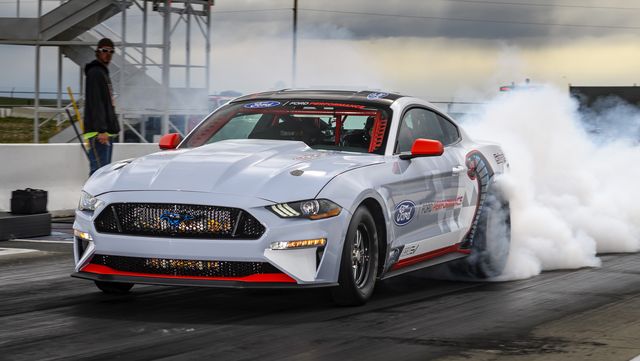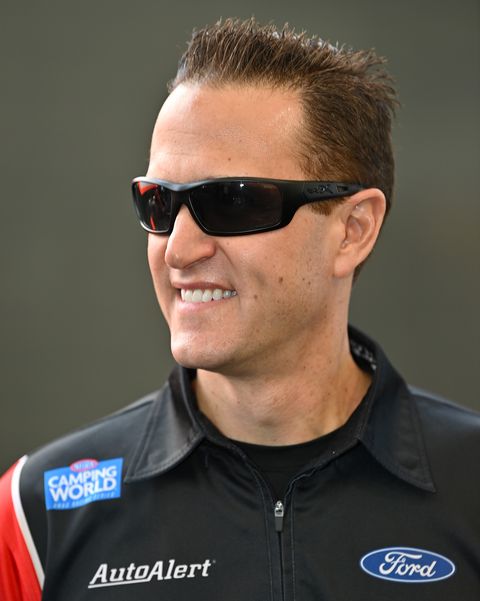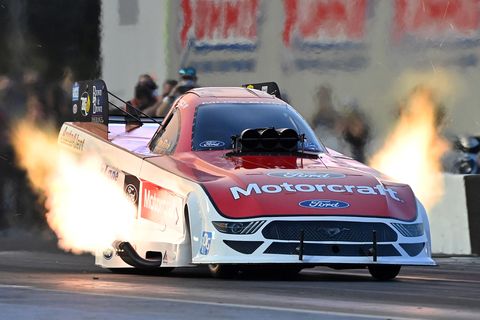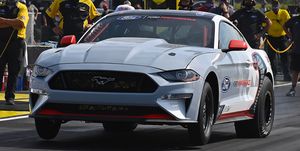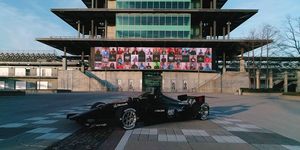For Bob Tasca III, his grandfather’s word was gospel. And being a faithful believer has shaped the Motorcraft/Quick Lane Mustang Funny Car driver into a highly successful NHRA Camping World Drag Racing racer, automotive-industry businessman, and Ford Motor Company evangelist.
“My grandfather said something to me when I was a kid that I never forgot. He said, ‘In life, everything has a beginning, a middle, and an end. Plan accordingly.’”
Today, as the automaker landscape is starting to include electric vehicles and the still-Buck Rogers-ish autonomous cars, Tasca hears the echoes of his grandfather’s advice. He’s aware of the trend and mulling what that might mean to his Northeast network of auto dealerships.
“I believe electrification is the end of a lot of things but the beginning of many other things. As an entrepreneur, as a businessperson, I think you have to assess your business, how it will be impacted, and make the adjustments necessary to capitalize on it,” he said. “I mean, whenever there’s disruption in the marketplace there’s huge opportunity. And you can pretend it’s not happening and get left out in the cold potentially, or you can embrace it and figure out ways to really capitalize on it.
“That’s what I’m doing in my businesses,” Tasca said. “If I lost all my internal-combustion service work at my dealerships today, I’d be out of business. There isn’t a dealer in the country that would be in business, but that’s not going to happen. It’s not going to happen today. It’s going to happen over time and evolve—and as business owners and entrepreneurs we’re going to have to evolve, too.”
Vince Roman, CEO of Burns Stainless, a manufacturer of high-quality exhaust components, said during SEMA’s Motorsports Parts Manufacturers Council Trade Conference that electrification “is probably not one of those things that’s going to knock us out in my lifetime. I can see the aftermarket maybe getting hit before the racing will, because racing will stand for quite awhile.”
At the same time, TMG Performance’s Chris Thomson said the advent of electrification “absolutely terrifies us.” However, he said, “It is scary, but I’ve been doing this for such a long time that I remember when cars first got catalytic converters and everybody freaked out. Now you can have an emissions-legal car that will run in the drag races, that can run a 10-second ET, that you can drive down the road with air-conditioning on and get 28 miles per gallon.”
What might be slower to catch on, he said, are autonomous cars—and perhaps, by association, autonomous race cars. “I think what’s holding that back is liability,” Thomson said. A Carsurance.net blog predicted that “the autonomous vehicle global market is expected to reach $36 billion by 2025, with North America owning 29% of all the self-driving vehicles in the world.” Dampening that enthusiasm might be Thomson’s thought: “Who do you sue if there’s an accident?” That’s the thorny question today, in the wake of a handful of fatal incidents.
In the meantime, college engineering programs are diving into autonomous technology, inspired in no small way by the $1 million prize up for grabs this October 23 at the Indianapolis Motor Speedway’s Indy Autonomous Challenge. The competition is among universities to design software for self-driving modified Dallara IL-15 Indy Lights race cars to go head-to-head in a high-speed race around the world-famous two-and-a-half-mile oval.
Jason Fiorito—who is planning his own high-tech automotive and aeromotive innovation center at his Pacific Raceways dragstrip and road course near Seattle—was a bit lukewarm to the idea but had his own alternative.
His reaction to the unique race was “OK. Cool. But here’s what I want to see: I want to see a driver car compete with a driverless car. I don’t want to see a whole field of autonomous cars. I just don’t. You can play chess between two people, or you can play chess with a person versus a computer. Either one of those is interesting. Watching a computer play a computer? I couldn’t give a shit about that. I want to watch a person beat a computer. I want to watch a person beat an autonomous vehicle. I’m rooting for the person. There’s got to be a good guy and a bad guy. The computer’s the bad guy at that point.”
Tasca didn’t have much hope for the humans.
“We would lose 10 out of 10 times. An autonomous car, it just repeats,” he said. “The human element is what makes racing a variable. Autonomous technology, it’s going to do the same thing every time. The good drivers are the ones that screw up less, under pressure, under the different circumstances. I don’t want to see autonomous racing come and put me out of business.”
But Tasca isn’t concerned about that yet. “I think that’s a way down the road. I don’t even think it’s something we’re going to see on the racetrack anytime soon. You’ll see electrification before you see that.”
Already the Extreme E Series, which hosted the first of its five events (Desert X Prix, Saudi Arabia) Easter weekend and will race next May 29-30 at Lac Rose, Senegal (Ocean X Prix), is showcasing the performance of all-electric SUVs. (Its entire structure and logistics are designed to reduce motorsports’ carbon footprint and raise awareness for the effects of severe climate change—all while employing eco-friendly materials in the course of presenting exciting and gender-equal racing.) While intercontinental Extreme E isn’t scheduled to race in Europe or North America, it is attracting worldwide attention.
Before that, drag racing representatives—particularly Don Garlits and Team JEGS—had been putting electric race cars on the track for several years in testing and exhibition passes. Then this past September, during the U.S. Nationals at Indianapolis’ Lucas Oil Raceway, Tasca debuted the all-electric Ford Mustang Cobra Jet 1400 prototype that covered the quarter-mile in 8.27 seconds at 168 mph and reached 1,502 peak wheel horsepower.
Ford has invested $11.5 billion in electrification technology through 2022, according to Brian Novak, engineering supervisor on the Cobra Jet 1400. And Mark Rushbrook, the global manager of Ford Performance Motorsports, said after Tasca put the prototype through its first public paces that day that he and his engineers have “continued to fine-tune it, and now know we’re just scratching the surface of what we may be able to achieve with this much electric horsepower in a drag-racing setting.”
Novak said Ford is working with the NHRA to design electrification rules for the series. As they and others cooperate to do that, dragstrips have been disappearing from the landscape, too often the target of complaints about noise levels from encroaching neighbors. Fiorito wondered aloud if electric race cars might help preserve racing venues.
“I don’t see that,” Tasca said. “I mean, you still smoke the tires. They [electric race cars] still have a pretty high-pitch wine. They’re not nitro Funny Cars—they’re not that loud—but I don’t see electrification saving racetracks. I see electrification as another element to the sport of racing. You have Pro Stock cars. You have nitro cars. You have motorcycles. You’re going to have electric cars, and you’ll see those evolve over several decades. This isn’t something that’s just going to happen in one year and be finished. So these cars are still evolving.
“I’m a huge supporter of it. Excited to see what the manufacturers do with it over the next several years. And I think it’s going to be very exciting, very competitive racing,” he said. “I think to some degree it might bring an affordability level to racing, because the engines, they last. Their electric engines are bulletproof. As battery price and battery technology come down, I think there’s a huge affordability play, because you won’t have the maintenance that an internal-combustion engine has at the racetrack.”
As for the mixed anticipation of electric race cars, or electric cars in general, Tasca said, “I think some people should be terrified and some people are obviously excited about it.”
He said, “Electrification is a major disruptor to the industry, and I think it does a lot of things right. They talk about the circle of life and the internal engine is cleaner than an electric engine when you factor everything in. I disagree with that. I think there’s a payoff. It’s probably like maybe 30,000 miles or 28,000 miles before the electric engine catches the gas engine as far as environmentally friendly. Initially, I think the electric power is not as good for the environment. But as you take that over the life cycle of the vehicle and the emissions that aren’t present and how an internal engine breaks down and becomes worse for the environment as it gets older, the electric car is definitely better for the environment, long-term.”
Scott Elkins, race director for Extreme E, told his International Council of Motorsport Sciences colleagues a couple of months ago that he has been advising an unidentified group of well-heeled investors interested in sending electric cars into space for the first all-electric race on the moon.
“Good luck to ’em,” Tasca said with a grin. “I’ll watch them, but I’m not going to the moon.”
No matter what happens with autonomous vehicles and all-electric vehicles, Tasca has been paying keen attention so he can be prepared in not only his racing but also with his dealerships. And he’s over-the-moon-secure in putting his grandfather’s advice to smart use.
Chime in with your thoughts on the prospect of electric vehicles taking part in racing in the comments below. We’d love to hear them!
Source: Read Full Article

